

Modest Mussorgsky. Modest Petrovich Mussorgsky, 1870 For many years Mussorgsky's works were mainly known in versions revised or completed by other composers.
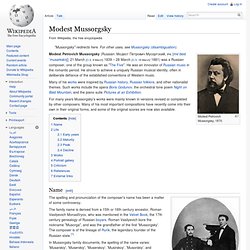
Many of his most important compositions have recently come into their own in their original forms, and some of the original scores are now also available. Name[edit] The aristocratic Mussorgsky brothers—Filaret (also known as "Yevgeniy", left), and Modest (right), 1858. The spelling and pronunciation of the composer's name has been a matter of some controversy. The family name is derived from a 15th or 16th century ancestor, Roman Vasilyevich Monastïryov, who was mentioned in the Velvet Book, the 17th century genealogy of Russian boyars.
In Mussorgsky family documents, the spelling of the name varies: 'Musarskiy', 'Muserskiy', 'Muserskoy', 'Musirskoy', 'Musorskiy', and 'Musurskiy'. Boris Godunov (opera) Boris Godunov, among major operas, shares with Giuseppe Verdi's Don Carlos (1867) the distinction of having the most complex creative history and the greatest wealth of alternative material.[3] The composer created two versions—the Original Version of 1869, which was rejected for production by the Imperial Theatres, and the Revised Version of 1872, which received its first performance in 1874 in Saint Petersburg.
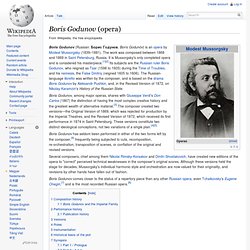
The Five. Anton Bruckner. Anton Bruckner (German: [ˈantɔn ˈbʀʊknɐ] ( Unlike other musical radicals, such as Richard Wagner or Hugo Wolf who fit the enfant terrible mould, Bruckner showed extreme humility before other musicians, Wagner in particular. This apparent dichotomy between Bruckner the man and Bruckner the composer hampers efforts to describe his life in a way that gives a straightforward context for his music. Antonín Dvořák. Antonín Dvořák Antonín Leopold Dvořák (/ˈdvɔrʒɑːk/ DVOR-zhahk or /dɨˈvɔrʒæk/ di-VOR-zhak; Czech: [ˈantoɲiːn ˈlɛopolt ˈdvor̝aːk] ( ); September 8, 1841 – May 1, 1904) was a Czech composer.
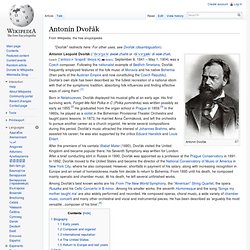
Following the nationalist example of Bedřich Smetana, Dvořák frequently employed features of the folk music of Moravia and his native Bohemia (then parts of the Austrian Empire and now constituting the Czech Republic). Amy Beach. Amy Beach Amy Marcy Cheney Beach (September 5, 1867 – December 27, 1944) was an American composer and pianist.
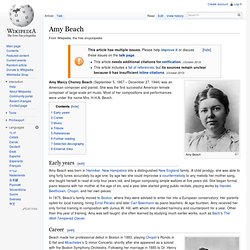
She was the first successful American female composer of large-scale art music. Most of her compositions and performances were under the name Mrs. H.H.A. Beach. Johannes Brahms. Johannes Brahms Johannes Brahms (German: [joˈhanəs ˈbʁaːms]; 7 May 1833 – 3 April 1897) was a German composer and pianist.
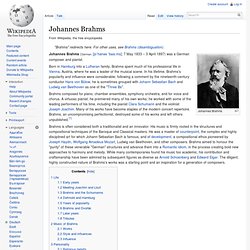
Symphony No. 4 (Brahms) The symphony is divided into four movements with the following tempo markings: Allegro non troppo (E minor)Andante moderato (E major)Allegro giocoso (C major)Allegro energico e passionato (E minor) A typical performance lasts about 40 minutes.
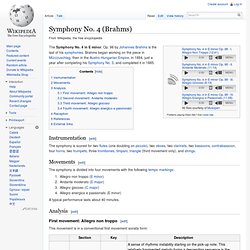
This movement is in a conventional first movement sonata form: Passacaglia. Bernardo Storace, last bars of Passagagli sopra A la mi re and beginning of Passagagli sopra C sol fa ut, from Selva di varie compositioni (Venice, 1664) The passacaglia (/pæsəˈkɑːliə/; Italian: [pasːaˈkaʎːa]) is a musical form that originated in early seventeenth-century Spain and is still used today by composers.
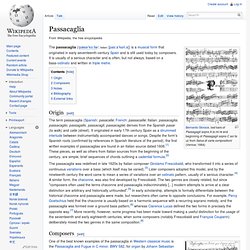
It is usually of a serious character and is often, but not always, based on a bass-ostinato and written in triple metre. Origin[edit] Developing variation. Though the term was coined by Arnold Schoenberg, inventor of the twelve-tone technique, he felt it was one of the most important compositional principles since around 1750:[1] References[edit] ^ Jump up to: a b c Haimo, Ethan. 1990.
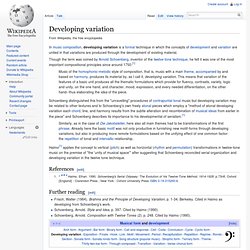
Schoenberg's Serial Odyssey: The Evolution of his Twelve-Tone Method, 1914-1928, p.73n8. Oxford [England] : Clarendon Press ; New York : Oxford University Press ISBN 0-19-315260-6. Further reading[edit] Piano Quintet (Brahms) The piece is in four movements: Allegro non troppo (F minor)Andante, un poco adagio (A♭ major)Scherzo: Allegro (C minor - C major)Finale: Poco sostenuto - Allegro non troppo - Presto, non troppo (F minor) This movement begins with a unison theme in all instruments.

It is in sonata form with the exposition repeated, and the second subject is a diminished fourth down (F minor moving to C sharp minor) transitioning to the enharmonic parallel major (D flat). A German Requiem (Brahms) Johannes Brahms around 1866 Brahms's mother died in February 1865, a loss that caused him much grief and may well have inspired Ein deutsches Requiem.

Brahms's lingering feelings over Robert Schumann's death in July 1856 may also have been a motivation, though his reticence about such matters makes this uncertain.[1] His original conception was for a work of six movements; according to their eventual places in the final version, these were movements 1–4 and 6–7.[2] By the end of April 1865, Brahms had completed the first, second, and fourth movements. The second movement used some previously abandoned musical material written in 1854, the year of Schumann's mental collapse and attempted suicide, and of Brahms's move to Düsseldorf to assist Clara Schumann and her young children.[1] Brahms completed all but what is now the fifth movement by August 1866.[3] Johann Herbeck conducted the first three movements in Vienna on 1 December 1867. Brahms assembled the libretto himself.
Symphony No. 1 (Brahms) The Symphony No. 1 in C minor, Op. 68, is a symphony written by Johannes Brahms. Brahms spent at least fourteen years completing this work, whose sketches date from 1854. Brahms himself declared that the symphony, from sketches to finishing touches, took 21 years, from 1855 to 1876. The premiere of this symphony, conducted by the composer's friend Felix Otto Dessoff, occurred on November 4, 1876, in Karlsruhe, then in the Grand Duchy of Baden. A typical performance lasts between 45 and 50 minutes. The form could be described as: A B A’ B’ C D C’ D’ A’’—Trio—A’’’ B ’’ A’’’’ Coda.
Giacomo Meyerbeer. Giacomo Meyerbeer, engraving from a photograph by Pierre Petit Giacomo Meyerbeer[1] (born Jacob Liebmann Beer; 5 September 1791 – 2 May 1864) was a German opera composer of Jewish birth who has been described as perhaps the most successful stage composer of the nineteenth century.[2] With his 1831 opera Robert le diable and its successors he gave the genre of grand opera 'decisive character'.[3] Meyerbeer's grand opera style was achieved by his merging of German orchestra style with Italian vocal tradition. These were employed in the context of sensational and melodramatic libretti created by Eugène Scribe, and were enhanced by the up-to-date theatre technology of the Paris Opéra.
They set a standard which helped to maintain Paris as the opera capital of the nineteenth-century. Born to a very wealthy Berlin family, Meyerbeer began his musical career as a pianist, but soon decided to devote himself to opera, spending several years in Italy studying and composing. Georges Bizet. Georges Bizet in 1875 Georges Bizet (French: [ʒɔʁʒ bizɛ]; 25 October 1838 – 3 June 1875), registered at birth as Alexandre César Léopold Bizet, was a French composer of the romantic era. Best known for his operas in a career cut short by his early death, Bizet achieved few successes before his final work, Carmen, which has become one of the most popular and frequently performed works in the entire opera repertoire. During a brilliant student career at the Conservatoire de Paris, Bizet won many prizes, including the prestigious Prix de Rome in 1857. He was recognised as an outstanding pianist, though he chose not to capitalise on this skill and rarely performed in public.
Carmen. The opera, written in the genre of opéra comique with musical numbers separated by dialogue, tells the story of the downfall of Don José, a naïve soldier who is seduced by the wiles of the fiery Gypsy, Carmen. José abandons his childhood sweetheart and deserts from his military duties, yet loses Carmen's love to the glamorous toreador Escamillo, after which José kills her in a jealous rage. The depictions of proletarian life, immorality and lawlessness, and the tragic death of the main character on stage, broke new ground in French opera and were highly controversial. After the premiere, most reviews were critical, and the French public was generally indifferent. The music of Carmen has been widely acclaimed for its brilliance of melody, harmony, atmosphere and orchestration, and for the skill with which Bizet musically represented the emotions and suffering of his characters.
Background[edit] Lucia di Lammermoor. Lucia di Lammermoor is a dramma tragico (tragic opera) in three acts by Gaetano Donizetti. Salvadore Cammarano wrote the Italian language libretto loosely based upon Sir Walter Scott's historical novel The Bride of Lammermoor.[1] Gaetano Donizetti. Fanny Mendelssohn. Felix Mendelssohn. Part song. Composers have also successfully used the part song medium to make contemporary arrangements of traditional folk song including that of Scotland, England, Wales and Ireland. Examples[edit] References[edit] Richard Wagner. Tristan und Isolde. Der Ring des Nibelungen. Gesamtkunstwerk. A Gesamtkunstwerk (translated as total work of art,[1] ideal work of art,[2] universal artwork,[3] synthesis of the arts, comprehensive artwork, all-embracing art form or total artwork) is a work of art that makes use of all or many art forms or strives to do so.
The term is a German word which has come to be accepted in English as a term in aesthetics. The German opera composer Richard Wagner used the term in two 1849 essays. It is unclear whether Wagner knew of Trahndorff's essay. Leitmotif. In particular, such a motif should be "clearly identified so as to retain its identity if modified on subsequent appearances" whether such modification be in terms of rhythm, harmony, orchestration or accompaniment. It may also be "combined with other leitmotifs to suggest a new dramatic condition" or development.[5] The technique is notably associated with the operas of Richard Wagner, although he was not its originator and did not employ the word in connection with his work.
Carl Maria von Weber. Carl Maria von Weber. Der Freischütz. Der Freischütz, Op. 77, J. 277, (usually translated as The Marksman[1] or The Freeshooter[2]) is a German opera with spoken dialogue in three acts by Carl Maria von Weber with a libretto by Friedrich Kind. It premiered on 18 June 1821 at the Schauspielhaus Berlin. Melodrama. Grand Opera. Singspiel. Giuseppe Verdi. La Scala. La traviata. Oratorio. Vincenzo Bellini. Norma (opera) Bel canto. Gioachino Rossini. The Barber of Seville.